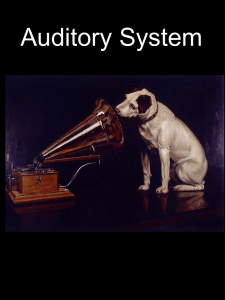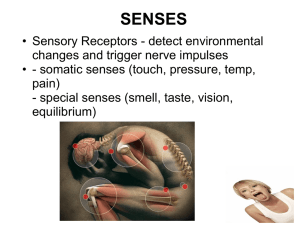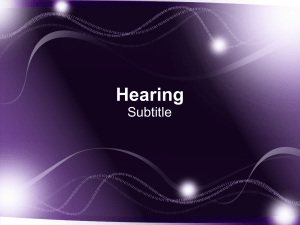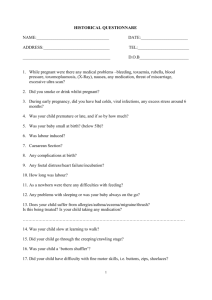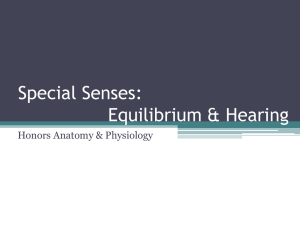Hearing - PEN-International
advertisement
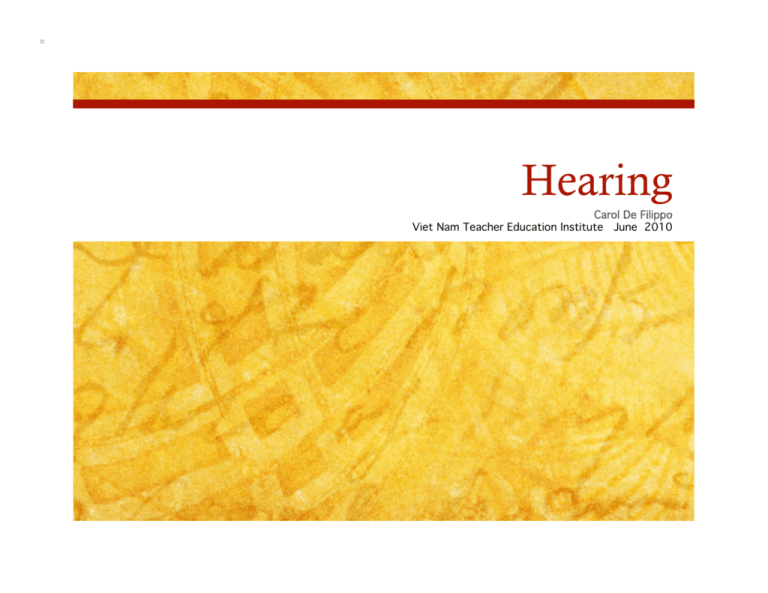
Hearing Carol De Filippo Viet Nam Teacher Education Institute June 2010 1 Hearing provides a connection to the world around you 2 Hearing provides awareness of your environment and a sense of security 3 In the dark Behind your back In emergency situations (horn alerts, shouts) When vision is impaired Hearing provides enjoyment Music Your child's voice The range of human emotions 4 Hearing provides "data" on the sounds of spoken language Spoken language develops from: Knowing the sound system of a language + Having the desire to communicate Hearing provides a natural path to spoken language ① Spoken language opens many options for communication Offers multiple models, multiple varieties Exposure to adult models at home Exposure to wide range of world knowledge through distance hearing Allows direct interaction with hearing individuals ② Spoken language is the foundation for learning to read Promotes internalization or representation of phonology of language Facilitates decoding during reading Provides basis for written English How much spoken language? How much hearing? Children and adults represent a range of experiences and abilities Fully visual Quite visual Equally auditory visual Quite auditory Fully auditory Sign language can work with listening and spoken language At certain times In certain situations The teacher considers individual need in balancing the two modalities How much emphasis on visual communication does the child need Where the child is in his general development Example: Sign is used at home with an infant who is a cochlear implant candidate Hearing loss is identified early Child is too young for the CI Sign becomes a supplement to early spoken language development Vision is used to stimulate symbolic language learning and early communication After the CI, auditory meaning is mapped onto existing symbolic concepts Example: Child is already in a program that uses sign language and becomes a candidate for a cochlear implant After the CI, sign is used to bridge between new auditory sensations and existing language knowledge Teacher gradually shifts emphasis toward listening and auditory development Child relies more and more on listening and spoken language Teacher must continually raise expectations Example: Child has already established communication through sign language Sign can support auditory learning by easing frustrating situations Understanding in noisy situations Learning concepts that are more cognitively complex Once learned, child can transition to spoken language To clarify speech (difficulty controlling articulation; poor oral motor skills) To communicate with signing peers To support a specific learning style (difficulty with memory, word storage, word retrieval) Example: child uses spoken language in limited contexts Visual communication (sign) is primary for the child Sign and spoken language skills develop separately Examples of circumstances that suggest a sign dominant approach Family chooses a bilingual/bicultural approach Family has more than one deaf child who signs Child receives very limited benefit from listening devices To develop as an auditory learner To transition to becoming an auditory learner To supplement sign with listening and speech To enable listening and speech in limited settings How We Hear Sound is a pressure wave http://www.physicsclassroom.com/Class/sound/u11l1c.cfm High pressure regions push the eardrum inward Low pressure regions pull the eardrum outward The continuous arrival of high and low pressure regions sets the eardrum into vibration http://www.physicsclassroom.com/mmedia/waves/edl.cfm Dimensions of sound Frequency (“pitch”) Amplitude (“loudness”) Duration (“length”) Speech is a complex combination of dimensions that change rapidly over time Outer ear Middle ear Mechanical energy Inner ear Air-borne waves of energy Hydraulic energy Central auditory pathway to the brain Electrical impulses Earlobe (Pinna) Collects sound waves Helps to localize sound Holds the earmold for a hearing aid If an earmold irritates the skin, the earmold can be modified Outer ear canal Amplifies middle frequencies (2000-4000 Hz) about 10 dB Protects middle and inner ear Cartilage section produces wax (cerumen) to keep out foreign objects Maintains temperature Bony section protects the ear Provides a place for an in-the-canal (ITC) hearing aid Tympanic membrane Collects sound energy like a funnel Transfers energy to the middle ear bones Provides about 25 dB of amplification Ossicles Oval window Malleus (”hammer") Incus (”anvil") Stapes (”stirrup") 1/30th the size of the eardrum Causes a surge of pressure in the inner ear Muscles and ligaments Hold the ossicles in place Protect the ear from excessively loud sound Eustachian tube Ventilates the middle ear Equalizes air pressure to match environmental pressure so the ear can operate normally Drains fluid out of the middle ear Fluid is created by the lining of the middle ear space Malfunction can lead to middle ear infection Oval window Cochlea Opens into the cochlea Contains the sensory cells (hair cells) for hearing Transmits pressure waves to the hair cells Organ of Corti Converts mechanical energy into electrical energy (electrochemical impulses) Outer hair cells (~ 13,000) Inner hair cells (~3500) Causes synapses to stimulate the auditory (8th) nerve Afferent fibers (to the brainstem) and Efferent fibers (for regulatory feedback) http://www.neurophys.wisc.edu/h&b/auditory/animation/animationmain.html Ipsilateral & contralateral pathways Numerous processing stations To the temporal lobe (auditory cortex) Source: http://www.e-a-r.com/hearingconservation/videos/Brandon%20Pletsch%20full%20animation%20HiFi.mpg The sense of hearing is accomplished by a process known as auditory transduction. The ear converts sound waves in the air into electrical impulses, which can be interpreted by the brain. As sound enters the ear, it passes through the external auditory canal where it meets the tympanic membrane. The tympanic membrane then vibrates in response to the sound. Sounds of a lower pitch, or frequency, produce a slower rate of vibration. And sounds of lower volume, or amplitude, produce a less dramatic vibration. Higher frequency sounds produce faster vibrations. The tympanic membrane is cone-shaped and articulates with a chain of three bones, called the auditory ossicles. They consist of the malleus, the incus, and the stapes. The movements of the tympanic membrane vibrate the ossicles, passing on the information of frequency and amplitude. The three bones pivot together on an axis shown here in red. The pivotal axis is due to a series of ligaments, which hold the bones in place within the middle ear cavity. Two structures have been removed (shown as green tubes) so you can see the ossicles better. Through the ossicles, the vibrations of the tympanic membrane are transferred to the footplate of the stapes. The stapes moves like a piston, which sends vibrations into a structure called the bony labyrinth. The labyrinth is filled with a fluid called perilymph. If it were a completely closed and inflexible system, the movement of the stapes would be unable to displace the perilymph and therefore unable to send vibrations into the bony structure. Due to the flexibility of a membrane called the round window, the stapes movement can displace the perilymph, allowing vibrations to enter the labyrinth. The corridor leading to the round window is found within the spiral portion of the bony labyrinth known as the cochlea. Vibrations produced by the stapes are drawn into the spiral system and returned to meet the round window. The portion of the spiral passage in which vibrations ascend to the apex of the cochlea is called the scala vestibuli. The descending portion of the passage is called the scala tympani. A third structure, called the cochlear duct, is situated between the scala vestibuli and the scala tympani. The cochlear duct is filled with a fluid called endolymph and, when viewed in cross-section, the membranes separating the two fluid-filled systems are visible. They are Reisner's membrane and the basilar membrane. The membranes are flexible and move in response to the vibrations traveling up the scala vestibuli. The movements of the membranes then send the vibrations back down to the scala tympani. A specialized structure, called the Organ of Corti, is situated on the basilar membrane. As the basilar membrane vibrates, the Organ of Corti is stimulated, which sends nerve impulses to the brain via the cochlear nerve. The actual nerve impulses are generated by specialized cells within the Organ of Corti called hair cells. The hair cells are closely covered by a structure called the tectorial membrane. As the basilar membrane vibrates, the tiny clusters of hairs are bent against the tectorial membrane, triggering the hair cells to fire. The entire basilar membrane does not vibrate simultaneously. Instead, specific areas along the basilar membrane move variably in response to different frequencies of sound. Lower frequencies vibrate the basilar membrane closer to the apex of the cochlea, whereas higher frequencies produce vibrations closer to the base. This arrangement is known as tonotopic organization. Together, this sequence of events is responsible for our acoustic perception of the world around us.


